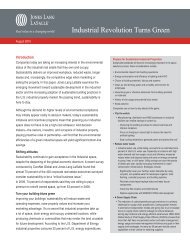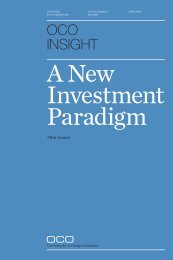PDF: 21st Annual Corporate Survey Complete Results - Area ...
PDF: 21st Annual Corporate Survey Complete Results - Area ...
PDF: 21st Annual Corporate Survey Complete Results - Area ...
You also want an ePaper? Increase the reach of your titles
YUMPU automatically turns print PDFs into web optimized ePapers that Google loves.
ankings. And railroad service and waterway or oceanport<br />
accessibility took the last two spots among the factors<br />
— just as they did in 2005. However, they both<br />
decreased in importance. Railroad service lost 8.1 percentage<br />
points and waterway or oceanport accessibility<br />
lost 3.2 percentage<br />
21<br />
points. Accessibility to major airport,<br />
on the other hand, st <strong>Annual</strong><br />
gained 11.4 percentage points,<br />
with 61.4 percent of the 2006 <strong>Corporate</strong> <strong>Survey</strong> respon-<br />
porate Analysis of the 2006 <strong>Corporate</strong> <strong>Survey</strong><br />
In comparing this year’s survey to those from past years,<br />
at a macro level, not much has changed. Simply stated,<br />
over the past five years:<br />
• the top-three ranked factors have always been in the<br />
top-four rankings (except for 2005);<br />
• the bottom-three factors have always been in the bottomthree<br />
rankings;<br />
• 15 of the top-15 ranked factors have not changed;<br />
• eight of the top-10 factors have always been the same; and<br />
• the factors rarely change more than 3–4 percentage<br />
points from the previous year’s selections.<br />
Although the order of the ranking has not changed much,<br />
the 2006 results have seen several factors change in the percentage<br />
of respondents indicating “very important” or<br />
“important” in their weighting selections. Specifically, labor<br />
costs increased seven percentage points, corporate tax rate<br />
increased about six percentage points, and availability of<br />
telecommunications services increased 8.5 points. Again, it is<br />
fairly typical to see a 3–5 percent fluctuation; therefore, there<br />
is obviously a serious focus on these issues. The focus on low<br />
operating costs — criteria ratings as well as reasons for<br />
decreasing facilities — and the dramatic jump in importance<br />
of availability of unskilled labor (50 percent up to 65 percent)<br />
especially in China points to the current economic climate of<br />
the continuing importance of product cost margins.<br />
This survey is dominated by the manufacturing, warehouse,<br />
and distribution sectors (combined 88 percent of<br />
dents rating this factor as “very important” or “important”<br />
as compared to only 50 percent of the 2005 survey<br />
respondents giving it a similar rating.<br />
It is quite surprising that this year’s survey respondents<br />
did not place more importance on the supplier<br />
and market proximity factors as well as the factors related<br />
to rail and water transport, considering the increasing<br />
importance of international trade. Perhaps those<br />
By Les J. Cranmer, Senior Managing Director, and<br />
Art M. Wegfahrt, <strong>Corporate</strong> Managing Director,<br />
Studley, Inc.<br />
respondents) and, therefore, overwhelmingly reports the<br />
current preferences of American manufacturers involving<br />
the business of making and/or moving goods. Based on this<br />
consideration, it is curious (if not surprising) that more<br />
change is not being reported relative to the importance of<br />
proximity to deepwater ports and rail service (these two factors<br />
are always ranked last and next to last). The dramatic<br />
growth of international trade is certainly causing significant<br />
modifications to supply-chain thinking — including significant<br />
volume increase in port and rail service.<br />
If one were to contrast these manufacturing/distributionsector–oriented<br />
results to the methods and factors commonly<br />
utilized on service-sector site selection projects, one key<br />
consideration stands out as being drastically different. The<br />
fact that the majority of all respondents indicate that they do<br />
not place much importance on the fact that similar employers<br />
(or jobs) may be in the target area (53 percent said they<br />
do not even consider this piece of data) suggests that interviews<br />
with competing local employers are not a method used<br />
during due diligence. This technique is a critical component<br />
of the service-sector location consideration — in order to<br />
collect real time current compensation, union election activity,<br />
and recruiting practices to calculate comparative operating<br />
costs.







